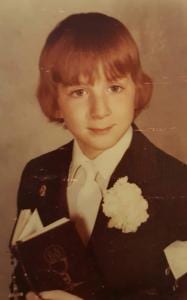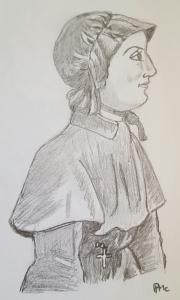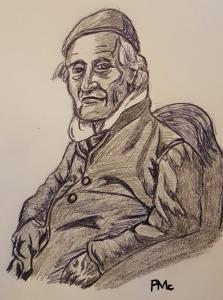 On a sunny Saturday morning in May 1976, I made my First Holy Communion at St. Thomas the Apostle Church in Queens. After the Mass, lots of people came to our house. I was seven years old; I wore a blue blazer with white pants and white shoes. And, let me tell you, I felt pretty important that day.
On a sunny Saturday morning in May 1976, I made my First Holy Communion at St. Thomas the Apostle Church in Queens. After the Mass, lots of people came to our house. I was seven years old; I wore a blue blazer with white pants and white shoes. And, let me tell you, I felt pretty important that day.
My favorite present was a book from my mother– Our Friends the Saints, by Daniel A. Lord, S.J. I’d always been interested in history, far more than comic books or science fiction. That book would be a big part of the reason why I became a Church historian. Published in 1956 and lavishly illustrated, it profiles 78 saints from Peter to Pius X. It still holds a cherished place in my library.
In a way I grew up with Catholic history. St. Thomas’s front lobby displayed a painting of Christ embracing a G.I., to commemorate parishioners who died in World War II. The statues, paintings and stained glass windows all beckoned to a Catholic past. (Later on, I found out that the church’s onion-dome steeple intentionally hearkened back to the founding pastor’s native Bavaria.) But Father Lord’s little book cemented my interest in Catholic history.
So who was this Father Lord? Known as the “Hollywood priest,” Daniel Aloysius Lord (1888-1955) helped produce the “Hays Code” that regulated movie morals for decades. He wrote ninety books, three hundred pamphlets, and many more articles, with sales reaching twenty-five million. One historian notes his unmatched ability to engage and energize youth… He made the truth attractive, spoke frankly about the church’s teachings and imparted his message with youthful enthusiasm.” High praise indeed!
For this child of the post-Vatican II era, Father Lord’s pre-conciliar enthusiasm was still infectious. The colorful illustrations included St. George in a golden suit of armor slaying a dragon, Joan of Arc ascending to heaven in spotless armor, as well as a triumphant Michael the Archangel. There were also characters in exotic robes, like Thomas Aquinas and Francis of Assisi. Francis Xavier was preaching to the people of Goa. All of them were historical figures, designed to attract a child’s interest and imagination, even in those “cynical seventies.”
Yes, the style was 1950’s Catholic– stressing the saints’ heroic courage, greater than that of any superhero. Take Lord’s description of Ignatius Loyola:
Ignatius was a brave soldier. One day he was wounded badly in battle. When he was getting well he read the Lives of the Saints. ‘What they did, I can do!’ he thought. And he became the brave soldier of Christ.
It stuck. Whether you grew up before or after Vatican II, to quote St. John Henry Newman, to be Catholic is to “be steeped in history.”
I went to a superb Catholic high school, Cathedral Preparatory Seminary, where the priest faculty effortlessly integrated Church and secular history. (How many high school classes today would, or could, spend a week on the theological controversies of the fourth century? Or a whole class on Newman alone?) They so aroused my historical interests that I went on to earn a Ph.D. in Church History from The Catholic University of America, and devote my life to writing it.
When Isaac Hecker, founder of the Paulist Fathers, converted to Catholicism in 1844, his friend Ralph Waldo Emerson asked him if it was art and architecture that “turned” his head. Hecker replied right away, “No, but what caused all that.” That quote describes the way I’ve tried to approach Church History, to find out what caused the saints to fall so much in love with God that they thought of nothing else but devoting their lives to God and God’s Church? What caused all that? And in what directions did it take them?
So today, in my own humble way, through my writing, I try to do the saints the justice they deserve. For me, what “caused all that” was a little book by a Jesuit priest from Chicago, who showed me that the saints are not just dusty historical figures. They are “our friends.” They’re also my heroes. If I still believe in heroes, it’s because I believe in the saints– in their love, courage, sanctity and their human warmth. One of my hopes in writing is that others will be as interested in them as I still am. It’s amazing what a First Communion present can do!











